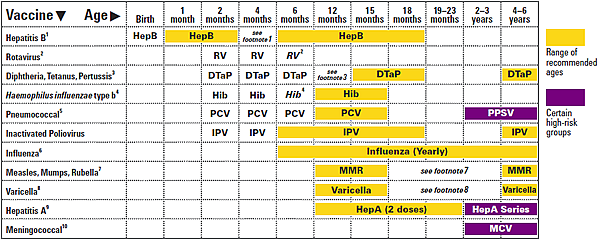Lesson 6: Prevention
Attention

Click HERE for information on Immunization from the MaineHealth Learning Resource Center
Learning Outcomes
Upon completion of this lesson's material, students will be able
- Explain the mechanisms of communicable disease spread
- Demonstrate knowledge of appropriate illness prevention practices
- Explain strategies for working with families about illness policies and procedures
Teaching
Children in group settings tend to get more illnesses. That’s why it is important to have policies addressing cleaning procedures, immunizations and illness exclusion. Many centers develop cleaning charts that detail how often areas need to be sanitized.
Here a couple of examples:
http://www.naeyc.org/files/academy/file/Cleaning_and_Sanitation_Chart.pdf (NAEYC)
http://www.snohd.org/Portals/0/Snohd/Family/files/WeeklyChild%20CareCleaningSchedule_CD.pdf (Snohomish Health District)
Germs can be spread by contact with bodily fluids, from the hands of staff and children, and contact with contaminated surfaces. Good hand washing practices should be taught to both staff and children. Gloves should be worn during diaper changes and when handling blood, stool or bodily fluids as well as washing hands after the incident. Although cleaning and hand washing are not an exciting part of the child care world, they are extremely important in order to limit everyone’s exposure to contagious illnesses.
Immunizations are required for group care and public school enrollment. This is a mandatory state law. The only exception to the rule is documentation when the family has medical, religious or philosophical beliefs against immunizations. When this is the case, the center has the right to exclude the child from attending after an outbreak of a contagious disease, such as Whooping Cough or Chicken Pox.
Staff should be trained to handle and clean up infectious disease contaminated items.
Although this lesson provides a basic overview, I would encourage you to take a certified Blood Born Pathogens training with hospital staff, OSHA (https://www.osha.gov/pls/oshaweb/owadisp.show_document?p_table=STANDARDS&p_id=10051) or other professional organization.
The basic procedure is as follows:
1. Stop other children or adults from entering the contaminated area
2. Put on protective gear, such as gloves or mask
3. Pick up items, using tongs if possible and disinfect the area using an approved disinfectant
4. Dispose of the contaminated items in plastic bags that are placed in a trash can that is out of reach of children
5. Remove protective gear and wash your hands or exposed body parts with soap and water immediately.
Do not allow children back in the area until it completely dry.
Head lice is a commonly transmitted issue in child care centers. When an outbreak occurs it is important to bag up all of the soft items and dress up clothes in plastic, air tight bags. Vacuum all surfaces and wash all toys and clothes. Items that can tolerate heat should be placed in the dryer. Although lice are not a medical emergency, it is important to handle the situation as quickly and thoroughly as possible to avoid spreading. Centers who have nap time should have separate bedding for each child which is laundered and sanitized regularly.
Children often place toys and objects in their mouths. They also spread germs by touching and playing with toys. Most sanitation charts require frequent disinfection of toys to lesson the transmission of germs.
Diapering stations are another area where sanitation is key. Please carefully read the procedures on pg 419 of your text. It is important to where gloves, dispose of the dirty diaper correctly and to disinfect the table afterward. Even though you where gloves, it is important to wash your hands afterward.
Assessment
Lesson 6 Quiz
Lesson Quizzes will consist of material from the lesson, the discussions, and from assigned reading. Questions will be True/False, Multiple Choice, and Short Answer. Be sure to review all the Lesson and Reading material prior to starting this quiz.
Lesson 6 Discussion
At this point in the class you are aware that some regulations can be set aside if the family/staff has religious or philosophical views about medical treatment, including immunizations. Discuss your thoughts on this controversial issue. Remember to be respectful about each others' viewpoints on this issue, but back up your statements with research data. We are all entitled to our own opinions, but we are not entitled to our own facts.